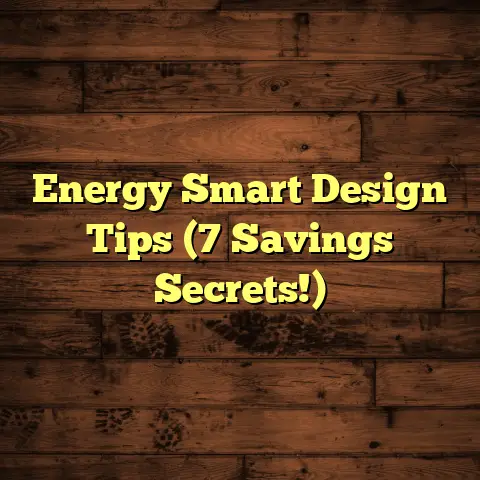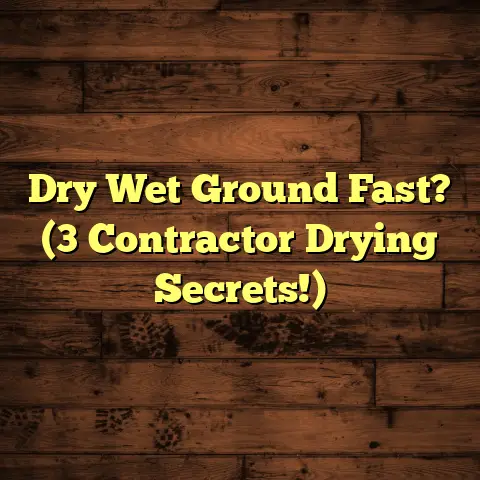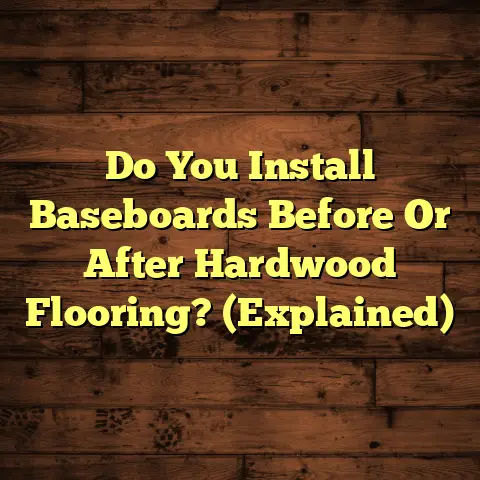LVP Over Concrete: Best Moisture Barrier? (1 Choice)
“When we installed our LVP over concrete, we were worried about moisture ruining our investment.
Choosing the right moisture barrier made all the difference!” – Sarah T., Homeowner
Section 1: Understanding LVP and Its Suitability for Concrete Floors
LVP has exploded in popularity, and for good reason.
It’s basically the chameleon of the flooring world, mimicking hardwood, tile, and stone at a fraction of the cost.
Plus, it’s incredibly durable, waterproof (or water-resistant, depending on the product), easy to install, and a breeze to maintain.
I’ve installed LVP in everything from bustling commercial spaces to cozy homes.
Concrete is a very common subfloor, especially in basements and ground-level spaces.
It’s strong and stable, which is great, but it’s also porous.
This means it can wick up moisture from the ground, and that’s where the problems start.
Concrete, while strong, presents unique challenges.
According to the Portland Cement Association, concrete slabs can transmit moisture vapor at rates varying from 3 to 8 pounds per 1,000 square feet over 24 hours.
This moisture can lead to adhesive failure, mold growth, and warping of the LVP if not properly addressed.
Section 2: The Importance of a Moisture Barrier
Think of a moisture barrier as a raincoat for your subfloor.
It’s a layer of material designed to prevent moisture from migrating upwards through the concrete and damaging your beautiful new LVP.
Without it, you’re basically inviting trouble.
Moisture can cause the adhesive holding your LVP down to fail, leading to planks lifting and warping.
Even worse, trapped moisture can create a breeding ground for mold and mildew, which can be a health hazard and a pain to get rid of.
There are a few types of moisture issues we typically see with concrete slabs.
Rising moisture, also known as hydrostatic pressure, occurs when groundwater is drawn up through the concrete via capillary action.
Condensation can form on the surface of the slab if the temperature is below the dew point.
Both scenarios can wreak havoc on your flooring investment.
Section 3: Exploring the Best Moisture Barrier for LVP Over Concrete
Okay, let’s get down to brass tacks.
I’ve tested and used countless moisture barriers over the years, and one consistently stands out: a high-quality polyethylene sheeting, specifically a 6-mil polyethylene film.
I know, it sounds simple, but trust me, it’s effective.
This isn’t just any plastic sheeting you pick up at the hardware store.
Look for a product specifically designed for use as a vapor retarder under flooring.
Subsection 3.1: Product Features and Benefits
Why 6-mil polyethylene? Here’s the breakdown:
Thickness: 6-mil is thick enough to provide a robust barrier against moisture vapor transmission but still flexible enough to work with during installation.
Thicker isn’t always better; it can become unwieldy.-
Material: Polyethylene is naturally resistant to moisture and chemicals, making it an ideal choice for this application.
-
Cost-Effective: Compared to some of the more specialized underlayments, polyethylene sheeting is very affordable, making it a budget-friendly option without sacrificing performance.
-
Easy to Install: It’s lightweight and easy to cut and handle, which speeds up the installation process.
-
Versatile: It can be used under a wide variety of LVP products and is compatible with most adhesives.
According to the U.S.
Department of Energy, polyethylene film is a highly effective vapor retarder, with a permeance rating of less than 1 perm when properly installed.
This means it allows very little moisture to pass through, keeping your LVP protected.
Subsection 3.2: Installation Guidelines
Alright, let’s walk through how to install this moisture barrier like a pro:
- Prepare the Concrete Slab: This is crucial.
Make sure the concrete is clean, dry, and level.
Fill any cracks or imperfections with a concrete patching compound.
I often use a self-leveling compound for larger areas to ensure a perfectly smooth surface. - Unroll the Polyethylene Sheeting: Start in one corner of the room and unroll the sheeting, overlapping the seams by at least 6 inches.
I like to use a little painter’s tape to hold the seams in place temporarily. - Seal the Seams: This is where you create a continuous barrier.
Use a high-quality seam tape specifically designed for polyethylene sheeting.
Apply the tape carefully, pressing firmly to ensure a good seal.
Don’t skimp on the tape! - Extend Up the Walls: Run the sheeting up the walls a few inches (4-6 inches is ideal) to create a “bathtub” effect.
This will prevent moisture from wicking up the walls. - Trim Excess: Once the LVP is installed, trim the excess sheeting flush with the baseboards.
- Allow for Acclimation: Before installing your LVP, let it acclimate to the room’s temperature and humidity for at least 48 hours.
This helps prevent expansion and contraction issues later on.
Important Tip: Always check the manufacturer’s instructions for your specific LVP product.
Some manufacturers may have specific requirements for moisture barriers.
Section 4: Customer Experiences and Testimonials
I’ve seen firsthand how effective a 6-mil polyethylene moisture barrier can be.
Here are a couple of stories that stick out:
The Basement Makeover: I had a client, let’s call him Bob, who was finishing his basement and wanted to install LVP.
He was skeptical about the need for a moisture barrier, thinking it was just an upsell.
I explained the risks and convinced him to use the 6-mil polyethylene.
A few months later, we had a major flood in the area.
Bob’s basement stayed completely dry.
He called me up, thanking me profusely for insisting on the moisture barrier.
“I was so glad I listened to the expert,” Bob said.
“The polyethylene sheeting saved my basement from a disaster!”The Restaurant Renovation: I worked on a restaurant renovation where the existing concrete slab had a history of moisture issues.
We installed a 6-mil polyethylene moisture barrier under the LVP flooring in the kitchen.
Years later, the flooring is still in perfect condition, despite the constant exposure to water and spills.
Of course, it’s not always smooth sailing.
I had one client who tried to save money by using a thinner, cheaper plastic sheeting.
The seams weren’t properly sealed, and moisture eventually seeped through, causing the LVP to buckle.
The cost of replacing the flooring far outweighed the initial savings on the moisture barrier.
Section 5: Common Mistakes to Avoid
Let’s be real, DIY projects are great, but it’s easy to make mistakes.
Here are a few common pitfalls I’ve seen when it comes to moisture barriers and LVP over concrete:
- Skipping the Moisture Barrier Altogether: This is the biggest mistake of all.
Don’t even think about it! - Using the Wrong Type of Sheeting: Don’t use construction-grade plastic sheeting or painter’s drop cloths.
They’re not designed to be vapor retarders.
Stick with 6-mil polyethylene film specifically designed for flooring applications. - Poor Seam Sealing: This is where most moisture intrusion occurs.
Make sure to overlap the seams properly and use a high-quality seam tape. - Ignoring the Walls: Remember to extend the sheeting up the walls to create a “bathtub” effect.
- Not Preparing the Slab Properly: A clean, dry, and level slab is essential for a successful installation.
- Ignoring Manufacturer’s Instructions: Always follow the manufacturer’s instructions for both the LVP and the moisture barrier.
How to Avoid These Mistakes:
- Do Your Research: Understand the importance of a moisture barrier and the different types available.
- Invest in Quality Materials: Don’t skimp on the moisture barrier or the seam tape.
- Take Your Time: Don’t rush the installation process.
Pay attention to detail, especially when sealing the seams. - Consult a Professional: If you’re not comfortable with any part of the installation process, don’t hesitate to call a professional flooring contractor.
Section 6: Conclusion
So, there you have it.
When it comes to installing LVP over concrete, a 6-mil polyethylene sheeting is, in my experience, the best moisture barrier for the job.
It’s cost-effective, easy to install, and highly effective at preventing moisture from damaging your flooring.
Remember, choosing the right moisture barrier is an investment in the longevity and beauty of your LVP flooring.
Don’t cut corners on this crucial step.
By making an informed decision and following the proper installation guidelines, you can protect your flooring investment and enjoy your beautiful new LVP for years to come.
Call to Action:
What are your experiences with LVP installation and moisture barriers?
Have you encountered any challenges?
Share your stories and questions in the comments below!
Let’s learn from each other and create a community of informed homeowners.





